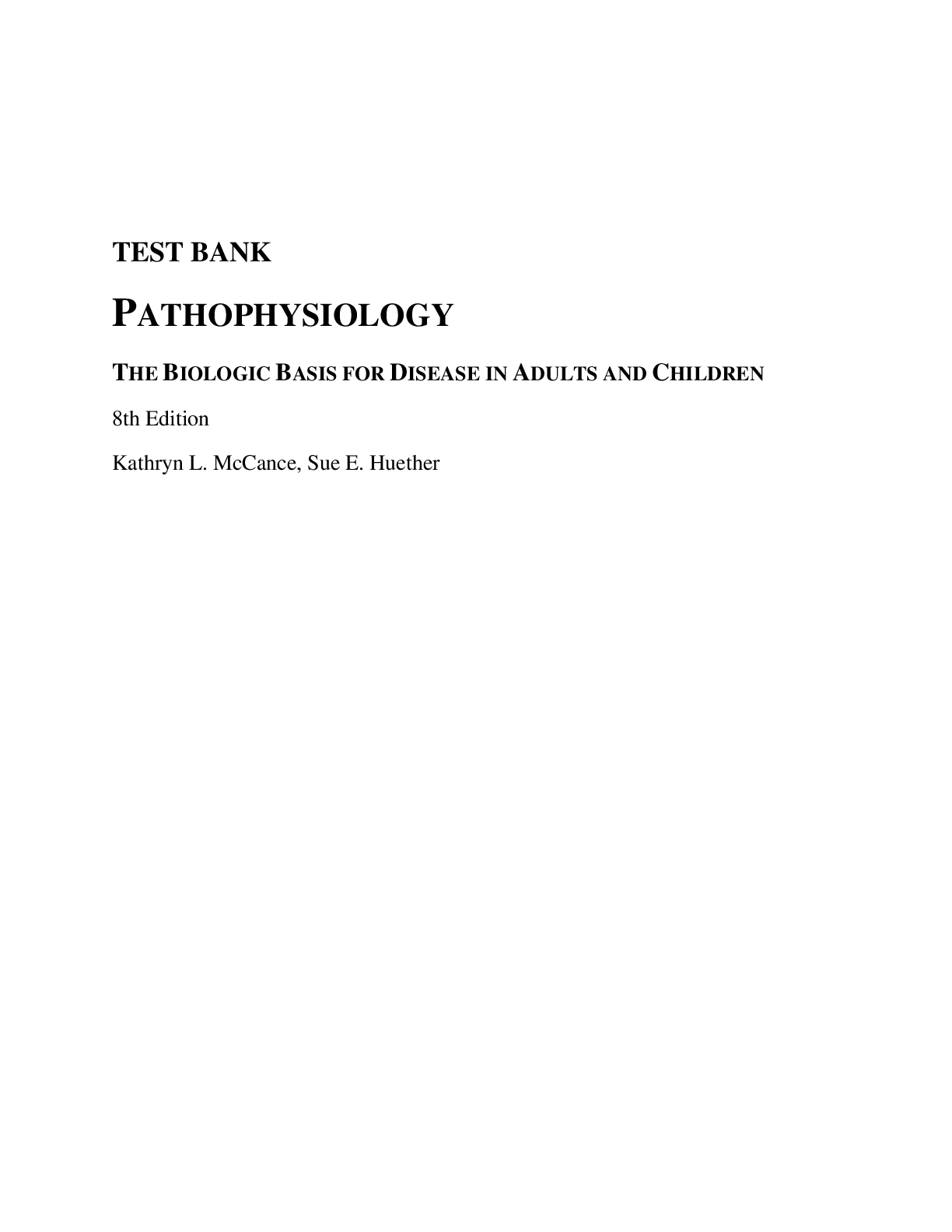MULTIPLE CHOICE
1.Which statement best describes the cellular function of metabolic absorption?
a. Cells can produce proteins.
b. Cells can secrete digestive enzymes.
c. Cells can take in and use nutrients.
d. Cells can synthesize fats.
ANS: C
In metabolic absorption, all cells take in and use nutrients and other substances from their
surroundings. The remaining options are not inclusive in their descriptions of cellular metabolic
absorption.
PTS: 1
DIF: Cognitive Level: Remembering
2.Where is most of a cell’s genetic information, including RNA and DNA, contained?
a. Mitochondria
b. Ribosome
c. Nucleolus
d. Lysosome
ANS: C
The nucleus contains the nucleolus, a small dense structure composed largely of RNA, most of
the cellular DNA, and the DNA-binding proteins, such as the histones, which regulate its
activity. The mitochondria are responsible for cellular respiration and energy production.
Ribosomes’ chief function is to provide sites for cellular protein synthesis. Lysosomes function
as the intracellular digestive system.
PTS: 1
DIF: Cognitive Level: Remembering
3.Which component of the cell produces hydrogen peroxide (H2O2) by using oxygen to remove
hydrogen atoms from specific substrates in an oxidative reaction?
a. Lysosomes
b. Peroxisomes
c. Ribosomes
d. Endosome
ANS: B
Test Bank - Pathophysiology: The Biologic Basis for Disease in Adults and Children (8th)
5
Peroxisomes are so named because they usually contain enzymes that use oxygen to remove
hydrogen atoms from specific substrates in an oxidative reaction that produces H2O2, which is a
powerful oxidant and potentially destructive if it accumulates or escapes from peroxisomes.
Ribosomes are RNA-protein complexes (nucleoproteins) that are synthesized in the nucleolus
and secreted into the cytoplasm through pores in the nuclear envelope called nuclear pore
complexes. Lysosomes are saclike structures that originate from the Golgi complex and contain
more than 40 digestive enzymes called hydrolases, which catalyze bonds in proteins, lipids,
nucleic acids, and carbohydrates. An endosome is a vesical that has been pinched off from the
cellular membrane.
PTS: 1
DIF: Cognitive Level: Remembering
4.Which cell component is capable of cellular autodigestion when it is released during cell injury?
a. Ribosome
b. Golgi complex
c. Smooth endoplasmic reticulum
d. Lysosomes
ANS: D
The lysosomal membrane acts as a protective shield between the powerful digestive enzymes
within the lysosome and the cytoplasm, preventing their leakage into the cytoplasmic matrix.
Disruption of the membrane by various treatments or cellular injury leads to a release of the
lysosomal enzymes, which can then react with their specific substrates, causing cellular self-
digestion. The chief function of a ribosome is to provide sites for cellular protein synthesis. The
Golgi complex is a network of flattened, smooth vesicles and membranes often located near the
cell nucleus. The smooth endoplasmic reticulum is involved in steroid hormone production and
removing toxic substances from the cell.
PTS: 1
DIF: Cognitive Level: Remembering
5.Which cAMP-mediated response is related to antidiuretic hormone?
a. Increased heart rate and force of contraction
b. Secretion of cortisol
c. Increased retention of water
d. Breakdown of fat
ANS: C
Antidiuretic hormone leads to increased retention of water in the body. Epinephrine causes
increases in heart rate and force of contraction. Increased cortisol secretion is due to ACTH.
Breakdown of fat is due to glucagon.
PTS: 1
DIF: Cognitive Level: Remembering
6.During which phase of the cell cycle is DNA synthesized?
a. G1
b. S
c. G2
d. M
Test Bank - Pathophysiology: The Biologic Basis for Disease in Adults and Children (8th)
6
ANS: B
The four designated phases of the cell cycle are: (1) the G1 phase (G = gap), which is the period
between the M phase (M = mitosis) and the start of DNA synthesis; (2) the S phase (S =
synthesis), during which DNA is synthesized in the cell nucleus; (3) the G2 phase, during which
RNA and protein synthesis occurs, the period between the completion of DNA synthesis and the
next phase (M); and (4) the M phase, which includes nuclear and cytoplasmic division.
PTS: 1
DIF: Cognitive Level: Remembering
7.What organic compound facilitates transportation across cell membranes by acting as receptors,
transport channels for electrolytes, and enzymes to drive active pumps?
a. Lipids
b. Proteases
c. Proteins
d. Carbohydrates
Read More

